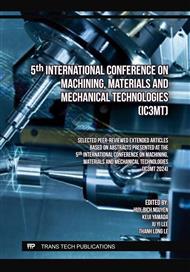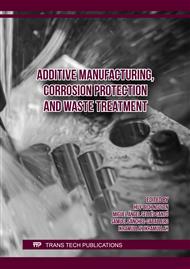p.3
p.13
p.21
p.31
p.39
p.47
p.59
p.65
Cutting Process of Rolled Ti-6Al-4V in Drilling of Countersunk Hole
Abstract:
Rolled titanium alloy has been widely applied to components in aerospace industry. The cutting force and the quality of hole are studied in drilling of countersunk hole of rolled titanium alloy with the crystallographic anisotropy. The periodical changes in the cutting force were observed in drilling of rolled titanium alloy, whereas in drilling of carbon steel, the cutting force increases without periodical changes due to isotropic material. The cutting force depends on the cutting direction angle, defined as the relative angle of the cutting direction with respect to the workpiece coordinate system. When the cutting direction is parallel to the rolling direction, the cutting direction angle is denoted as 0°, and when it is perpendicular, the cutting direction angle is denoted as 90°. The cutting force becomes stable around a cutting direction angle of 0°, while high frequency vibrations are observed in the cutting force around a cutting direction angle of 90°. The countersunk angle and the surface finish depend on the cutting direction angle. The cutting forces, then, are analyzed using an analytical force simulation. A three-dimensional chip flow is interpreted as a piling up of orthogonal cuttings containing cutting velocities and chip flow velocities. The cutting force is predicted by the determined chip flow model, where the chip flow direction is determined to minimize the cutting energy. The changes in the shear plane cutting model of rolled titanium alloy are discussed in the simulation. These findings provide better understandings of the effect of anisotropy in drilling to improve the quality of countersunk holes.
Info:
Periodical:
Pages:
3-11
Citation:
Online since:
March 2025
Keywords:
Price:
Сopyright:
© 2025 Trans Tech Publications Ltd. All Rights Reserved
Share:
Citation:



